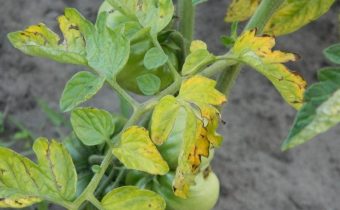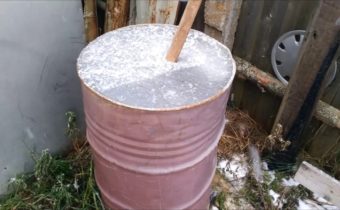How to destroy spider mites on tomatoes, what to do?
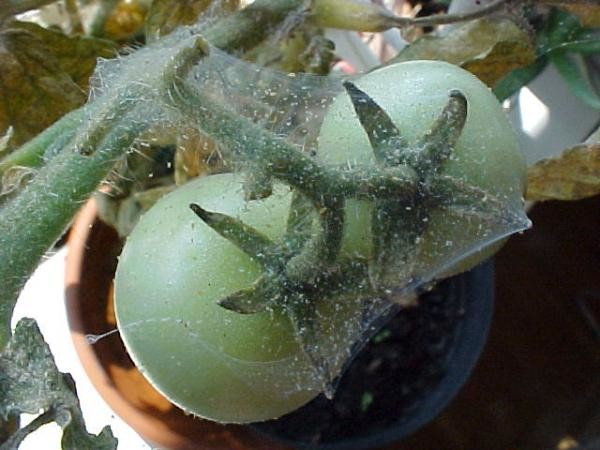
Spider mite often appears on the planting of tomatoes in the greenhouse, where there is a suitable microclimate for it and good conditions for wintering. Tomatoes in the shelter are more vulnerable to tick attacks - plants can be weakened due to lack of lighting, space saving forces gardeners to thicken rows, contributing to the rapid spread of the insect by planting. The inability to use crop rotation in greenhouses increases the risk of "chronic" pest damage.
Signs and causes of tomato spider mite damage
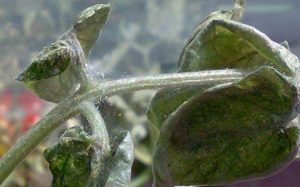 Insect feeds on plant sap, getting it from the leaves. Significant damage to the pest quickly depletes tomatoes, worsening their yield. Ticks are located on the back of the leaves, preferring the lower part of the bushes.
Insect feeds on plant sap, getting it from the leaves. Significant damage to the pest quickly depletes tomatoes, worsening their yield. Ticks are located on the back of the leaves, preferring the lower part of the bushes.
The size of the insect is too small (no more than 1 mm in length), so that you can notice it before the pest activity affects the health of the tomato.
Symptoms of tick attack tomatoes:
- discolored areas, white dots on leaves, occurring at prokus locations;
- twisting the lower leaves edge up, followed by drying and subsidence;
- small gray lumps that look like grains of dust on the back of the leaves;
- spiderweb, enveloping the leaves, the stem and the fruit.
The cobweb becomes noticeable already at the stage of a large destruction of planting with a spider mite, requiring the use of chemical agents.
Most often, the pest enters the greenhouse along with the seedlings or the earth mixture when it is renewed in the shelter of the soil layer. Infection of seedlings can also occur through the soil or from seedlings of other crops susceptible to tick infestation (eggplant, Bulgarian pepper). Particularly high risk of mite-affected plants when buying ready-made seedlings.
Finally, the spider mite can get into the greenhouse when planting ornamental or field plants between the rows in order to attract honeybees to pollinate tomatoes. Not only cultivated plants, but also some weeds can be food and a breeding ground for the pest.
In winter, the insect hides in the ground or under a layer of fallen leaves, untidy tops, etc. As a rule, appearing on tomatoes once, the tick will return in the following seasons. Therefore, the removal of the pest will require several treatments of plants, as well as soil and greenhouse.
Treatment measures
When choosing a method of dealing with spider mites, it is necessary to take into account the degree of damage to planting, the phase of development of tomatoes, the sources of pest spread.
Chemical acaricides and insectoacaricides
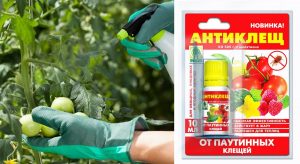 If the population of spider mites on tomatoes is significant, treatment of planting with chemical preparations is recommended. It is permissible to use poisons no later than 2-3 weeks before the harvest begins. If the attack of ticks is detected during the period of fruiting, it is necessary to confine ourselves to less toxic methods of treatment - folk or biological means.
If the population of spider mites on tomatoes is significant, treatment of planting with chemical preparations is recommended. It is permissible to use poisons no later than 2-3 weeks before the harvest begins. If the attack of ticks is detected during the period of fruiting, it is necessary to confine ourselves to less toxic methods of treatment - folk or biological means.
Anti-mite, Oberon, Flumate, Neoron, Fufanon, Iskra-BIO, Borneo, Aktellik will be effective chemicals against spider mites during the growing season. Spraying spend 2 times during the growing season with an interval of 3 weeks.The most powerful means, but differing and high level of toxicity, is Carbophosphorus. To resort to the drug should be only in extreme cases.
It is necessary to process not only plants, but also the ground and the walls of the shelter. For disinfection of the soil from chemical agents, drugs based on iodine - “Pharmaiod”, “Povidone-iodine” are best suited. Chemical processing of the greenhouse is done along with spraying of the planting, but the main work on cleaning the shelter is carried out after harvesting.
Predatory mites and biologics
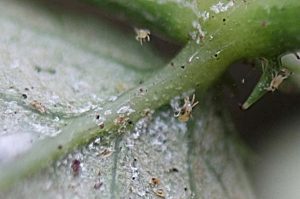 Means of this type are preferable to chemical for processing plantings in the greenhouse - because of the inability to fully apply the crop rotation, pesticides quickly accumulate in the ground under the shelter. Biological agents are safe for harvest, they can be used during the flowering and fruiting of tomatoes.
Means of this type are preferable to chemical for processing plantings in the greenhouse - because of the inability to fully apply the crop rotation, pesticides quickly accumulate in the ground under the shelter. Biological agents are safe for harvest, they can be used during the flowering and fruiting of tomatoes.
To combat spider mites, they plant predatory mites that feed on eggs and adults, or treat plants with preparations containing bacteria that infect the pest. Of the bacterial preparations, good recommendations for gardeners received the proven “Fitoverm”, as well as “Kraft”, “Agrovertin”, “Bitoxibacillin”, “Kleschevit”.
Folk recipes
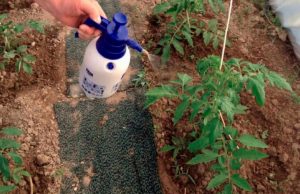 With a small pest infestation of planting cultivation with folk remedies in combination with agrotechnical techniques, the population can be reduced and the spider mite gradually removed. The effectiveness of home remedies is lower than that of specialized drugs, in the first place it is advisable to use them to prevent the reappearance of the tick.
With a small pest infestation of planting cultivation with folk remedies in combination with agrotechnical techniques, the population can be reduced and the spider mite gradually removed. The effectiveness of home remedies is lower than that of specialized drugs, in the first place it is advisable to use them to prevent the reappearance of the tick.
The most effective anti-tick recipes:
- Alcohol. Shrubs are sprayed with 96-98% alcohol, diluted with water at the rate of 2 tablespoons per liter. The treatment is carried out twice or three times with a break of 7 days.
Alcohol is also effective for disinfecting the greenhouse. In this case, use a concentrated substance, without diluting with water.
- Soap solution. The most powerful tool - tar soap, you can use the usual economic. Grate half the bar and dissolve in a small amount of hot water. After the solution does not remain solid parts, you need to dilute it with 0.5 liters of water.
- Aloe. Squeeze the juice from 2 kg of aloe leaves, diluted with 10 liters of water and add to the solution soap shavings from 1/4 of the bar. Spraying is carried out once a week throughout the season.
- Bow. It is necessary to fill with 4 liters of warm water 200 g of onion peel, insist 5 hours. Onions can be replaced with 400 g of crushed garlic heads.
- Garlic and dill. It takes 1 kg of dill leaves and 200 g of garlic fruit. Raw materials must be crushed. Dill pour boiling water and let it brew for 3 hours. After filtering, add garlic and leave to infuse for a day. After the second filtering infusion is ready for spraying the bushes.
- Potato tops. A bucket of warm water to pour 1.2 kg of raw materials and insist 4 hours.
- Marigold. After collecting and drying the flowers of marigolds, you should fill the bucket with half of them and pour in 5 liters of warm water. Need to insist 2 days in a dark room.
Healthy plants that grow next to the affected spider mite should be sprayed with infusions to scare off the pest:
- Horseradish. Fill the bucket with 1/3 crushed leaves and shoots of fresh horseradish, pour water to the edge of the container. You need to insist 1.5 hours, after straining - spray planting tomatoes. The treatment is repeated after 12 days.
- Yarrow Dried and crushed green parts of the plant (700 g) are poured with a bucket of boiling water. Insist should be 3 days.
- Henbane. Insist 1 kg of dry raw materials in a bucket of water for about half a day. After filtering sprayed landing. The second treatment is repeated after a week.
- Sagebrush. 10 g of water is poured 800 g of dry wormwood and insist 2 days. After this, the infusion should be boiled for half an hour and diluted with another 10 liters of cold water.
- Dandelion leaves and roots.400 grams of crushed leaves and rhizomes pour 10 liters of water and allow to infuse for 2 hours. Straining the infusion, spend spraying. After 2 weeks, the procedure is repeated.
- Tobacco. 400 grams of chopped tobacco leaves should be poured with warm water, infused for 24 hours.
Agrotechnology
When spider mites are found on tomatoes, additional measures are needed to take care of the plants:
- With a small lesion, it is advisable to dig out the diseased bushes from the garden, preventing further spread of the insect.
- You should regularly inspect the planting and remove the affected pest leaves. Like excavated bushes, the removed parts of the plant need to be burned.
- It is recommended to spray the planting of tomatoes with clean water - the mite does not like excess moisture.
This measure should not be used during the flowering period of tomatoes in order to avoid sticking of pollen, which complicates pollination and, as a result, reduces the number of ovaries.
- In the autumn, after harvesting the tops, it is necessary to disinfect the greenhouse. Treatment with alcohol (96%), bleach (10%), copper sulphate (5%) is recommended. Any chemical product will also work, especially recommended for this purpose "Sunmite". If there is an opportunity, it is worthwhile to carry out the processing of the shelter in a disassembled form, this will remove ticks from hard-to-reach places.
- Digging the ground and fumigating the greenhouse with sulfur will help to end the fight against the pest. Carry out the procedure in the fall or spring at a temperature of 10-15 ° C. At 1m3 of space will need to burn 200 g of sulfur. Fumigation is carried out with the doors closed, leave the shelter for 5 days, after which it is well ventilated (at least 2 days).
Prevention
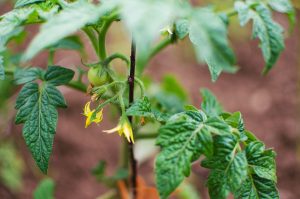
Removing a spider mite from a greenhouse is a costly and time consuming business, so it is worth considering the “tastes” of the pest and initially creating unfavorable conditions for it.
A few rules will help minimize the risk of an insect:
- It is necessary to conduct heat treatment of the soil for seedlings - this ensures that insects that are hiding in the soil will die. Suitable warming in the oven.
- It is impossible to make rows of tomatoes too thick - this contributes to the spread of mite on planting. It is recommended to maintain a distance of 30 cm between the holes for planting seedlings in the greenhouse.
- Planting crops that deter pests are recommended next to tomatoes. These include basil, dill, garlic, mustard, celery, chrysanthemum and calendula.
- Plants require good nutrition with phosphorus, introduced by the root method. The mite does not like soils saturated with the element.
- It is necessary to observe moderation in nitrogen feedings. Excess nitrogen in the soil favors the appearance of mites.
- It is important to maintain the cleanliness of the beds, not overgrowing weeds. Autumn should be removed from the site of the tops of tomatoes and carry out deep digging of the soil.
In the fight against or prevention of spider mites, it is important to remember that there are plants at risk that are deficient in any resource (water, light, nutrition), weakened by diseases or mechanical damage. Not only special measures, good care in general increases the resistance of tomatoes to pest damage.



